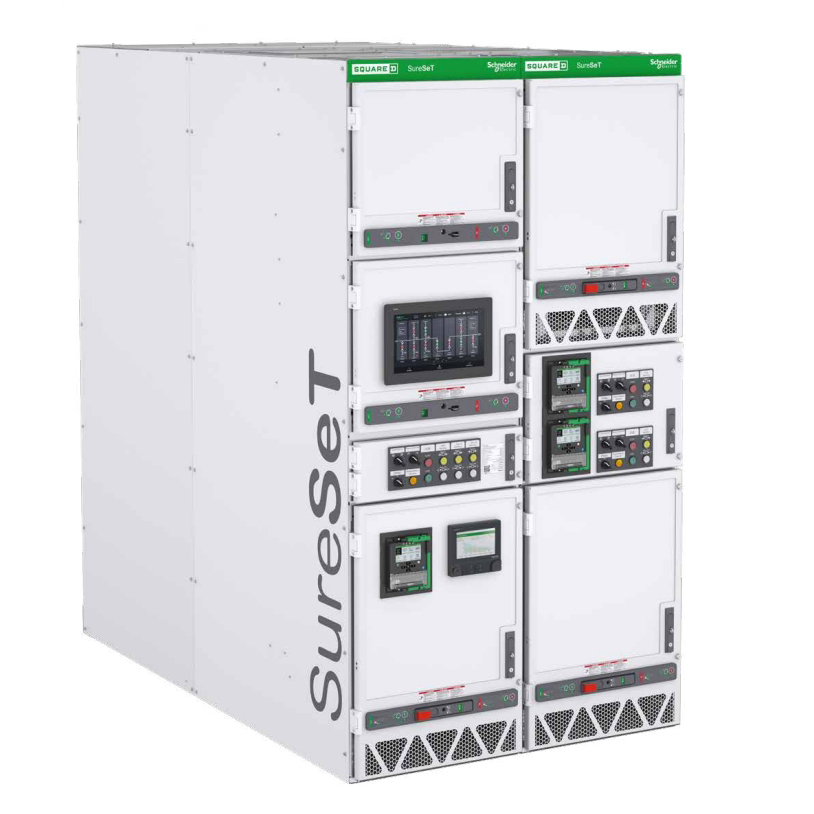
Introduksyon:
Ang mga 10kV gas-insulated RMUs (Ring Main Units) gitawag og importante tungod sa ilang daghang abilidad sama sa pagka fully enclosed, high insulation performance, no maintenance required, compact size, ug flexible ug convenient installation. Sa karon, sila naging critical node sa urban distribution network ring-main power supply ug nag-ila sa significant role sa power distribution system. Ang mga problema sa gas-insulated RMUs mahimong makapadako ang impact sa tanang distribution network. Para masiguro ang reliability sa power supply, importante nga seriyo ang pag-address sa mga problema sa 10kV gas-insulated RMUs ug implementar ang appropriate measures para mapasabot, aron madaghan ang reliability sa power supply.
I. Pagpakilala sa 10kV Gas-Insulated Multi-Compartment RMUs
Ang serye sa 10kV gas-insulated RMU (kasagaran gipangutana og multi-compartment RMU, fully insulated cabinet) adunay compact mechanical structure, small volume, light weight, all-weather capability, excellent expandability, lightweight ug flexible modular installation, easy maintenance without disassembly, ug simple upkeep. Ang ilang technical parameters gi-divide ng reasonable batasan sa design ug functional features, ug sila mahimong icategory sa electrical cabinet types sama sa High-Voltage Non-Load Switching Units, Circuit Breaker Units, Load Switch-Fuse Combination Units, Cable Connection Units, ug High-Voltage Metering Cabinets.
Ang termino "multi-compartment RMU" nagrefer sa paggamit niini sa harmful gas media sama sa SF₆ isip primary electrical insulation ug contact medium. Kini naghatag kanila og significantly superior electrical insulation ug protective performance compared sa ordinary air-insulated cable cabinets. Ang electrical clearance sa fully insulated cabinets adunay generally narrower, kasagaran much narrower, kaysa sa equivalent semi-insulated cabinets sa same voltage rating. Konsekwente, sila adunay less space. Ang switch housing ug tanang live copper connection components permanent sealed sa stainless-steel shell filled with SF₆ gas, maintaining constant pressure unaffected by altitude. Sila usab suitable sa basements ug uban pang relatively humid, cold environments. Tungod sa kini nga characteristics, ang gas-insulated RMUs gigamit sa outdoor cable branch boxes ug prefabricated substations.
II. Common Problems sa 10kV Gas-Insulated Multi-Compartment RMUs
Sa karon, ang 10kV gas-insulated RMUs adunay higher proportion sa urban distribution networks kaysa sa uban nga types of RMUs. Regionally, bisan unsa pa ang few early-installed semi-insulated cabinets, ang tanang outdoor switching stations commissioned after 2007 mao ang gas-insulated RMUs. Ang ilang vital role obvious, tungod kay ang safe ug reliable operation direkta maapektuhan ang reliability sa power supply sa users. Ang common operational ug maintenance issues sa 10kV gas-insulated RMUs include problems sa RMU bushings ug cable connections, impacts sa humid operating environments sa RMU, ug SF₆ air tank failures.
2.1 Bushing ug Cable Connection Problems
Ang 10kV multi-compartment RMU design nagsugyot sa US ug Europe, diin adunay single-core cables. Kini nagresulta sa low cable compartments sa gas-insulated RMUs. Ang single-core cables facilitate easier fixing ug installation, ug ang ilang terminations close match sa RMU bushing terminals, ensuring no thermal overload faults occur ug providing resistance sa torsional stress sa bushings.
Sa China, adunay wide use sa three-core cables. Compared sa single-core cables, ang installation sa three-core cables adunay complex. Kasagaran, gamiton ang clamps o bolts aron i-secure ang outer cable sheath, difficult to simultaneously ensure absolute fixation sa tanang three cores. Tungod sa ilang shorter ug thicker diameter, even when the three-core cable itself secure connected ug fixed, ang torsional moments generated under the cable's own weight o any applied mechanical force directly transmitted sa cable bushings. Analysis sa recent RMU failures sa some regions indicate na dili common ang faults caused by inadequate connections sa RMU bushings ug cables.
2.2 Problems sa Humid Environments
Bisan ang 10kV gas-insulated RMUs designed sa all-weather operation, prolonged exposure sa humid environments, especially sa coastal areas, mahimong lead sa corrosion sa cabinet body ug other metal components. If the sealing plates sa RMU cover panel o sa cable trench entry point dili tight, moisture from the cable trench easily infiltrates the RMU cover ug interior. Kini can lead sa significant water evaporation forming condensation. Kini highly prone sa causing faults sa indicators, voltage indicators, ug internal operating ug control mechanisms. These components ug panel itself easily become damp, rusted, blocked, o corroded. Moist air can directly enter the RMU interior, causing chemical corrosion ug rusting sa cabinet body ug baseplate, drastically shortening the RMU's service life [1].
2.3 Air Tank Failures
Ang main cause sa SF₆ switch air tank short-circuit failures mao ang sudden leakage sa gas sa sealed SF₆ tank cavity tungod sa various physical reasons. Kini compromises ang integrity ug density sa SF₆ gas seal, ultimately resulting sa short-circuit failure sa moving ug fixed contacts sa normal operating conditions, leading sa accident.
Leakage points mostly found sa cable terminals (cable ends inside the tank). Kini primarily due sa non-standardized cable installation, causing excessive stress sa terminals ug leading sa cracks sa junction sa air tank ug cable terminal, resulting sa SF₆ gas leakage. Thus, air tank failures usab reflect poor construction practices. Second, inherent manufacturing process issues sa some RMUs can cause inadequate sealing sa certain areas, leading sa leakage.
2.4 Cable Termination Faults
Sa karon, one of the most common causes sa failure sa 10kV gas-insulated RMUs mao ang external flashover sa cable terminations, caused sa poor workmanship o substandard materials sa fabrication. Kini leads sa RMU failure.
III. Countermeasures ug Preventive Measures
Ang mga nabanggit nga problems mahimo ang address ug prevent sa pamaagi sa sumala:
3.1 Increase the Height sa 10kV RMU Cable Compartment
Para matackle ang issue sa narrow, low-height cable compartments sa multi-compartment RMUs, most manufacturers opt sa increase sa compartment height. When a European brand entered the Chinese market, it adapted sa change sa terminal block layout from stepped to horizontal, following Chinese preferences, thus improving cable compartment space utilization. During installation, the indoor RMU can be elevated using an appropriately sized box-type base. For outdoor cable branch boxes, the foundation height can be raised.
3.2 Employ Natural Ventilation o Install Dehumidification Devices
Sa karon, ang direct, effective, ug reliable method sa prevention sa harmful moisture ingress mao ang completely seal sa RMU cable compartment floor using sealed fireproof structural materials. Kini effectively blocks outdoor humid air, prevents small animal intrusion, ug helps prevent vegetation growth – achieving multiple benefits. Indoor RMUs must utilize dedicated dehumidification equipment o automatic humidity control systems. Outdoor cable branch boxes can have their foundations raised ug an appropriate number of ventilation/heat dissipation openings arranged around the bottom para facilitate moisture dispersion from cable trenches/pits. However, openings should not be excessive, ug measures to prevent small animal hazards must be considered. Additionally, if a cable branch box contains a Potential Transformer (PT) ug ventilation allows, a small air conditioning dehumidifier can be installed.
3.3 Strengthen Operation ug Maintenance Management
SF₆ tank failures can cause major accidents. Therefore, selecting devices with stable quality crucial, ug management during construction must be strengthened. Relevant technical specifications from China Southern Power Grid explicitly require that air tanks be made of stainless steel >2mm thick, capable of withstanding normal ug transient pressures encountered during use, ug equipped with SF₆ pressure gauges ug filling ports. Operators must regularly monitor tank pressure during routine maintenance. Especially before switching operations, confirming normal internal pressure vital to avoid accidents due to leakage. Any detected leaks must be addressed promptly.
3.4 Ensure Strict Control sa Cable Termination Fabrication ug Daily Management
Para prevent RMU failures caused sa defective cable terminations, essential nga carefully select qualified cable terminations meeting quality requirements. Installation personnel must strictly adhere sa national standards during termination fabrication. Inspectors must rigorously enforce quality acceptance checks para prevent substandard terminations from being put into service. Furthermore, operation ug maintenance units must diligently maintain cable termination records ug categorize/analyze terminations exhibiting potential problems encountered during routine operation. This ensures timely identification sa family defects ug helps avoid the recurrence sa similar quality issues ug accidents [2].
IV. Conclusion
Tungod sa ilang numerous advantages, ang 10kV gas-insulated RMUs gradually became a critical node sa ring-main power supply sa urban distribution networks, playing a vital role sa power distribution system. This article illustrates several prevalent problems sa 10kV gas-insulated multi-compartment RMUs ug proposes corresponding solutions ug preventive measures. The goal mao ang reduce the failure rate sa 10kV gas-insulated RMUs ug enhance power supply reliability. Having evolved over many years, ang 10kV gas-insulated RMUs now the primary nodes sa urban ring-main distribution networks. Their safe ug reliable operation directly impacts the reliability sa power supply provided by electric utilities. In actual operation, various fault types can occur sa 10kV gas-insulated RMUs due sa environmental factors o quality issues, leading sa decline sa power supply reliability.






















